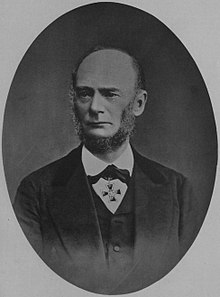Rudolf von Bernhard
Rudolf Bogdanovich Bernhard ( Russian Рудольф Богданович фон Бернгард ; born May 20, jul. / 1. June 1819 greg. In Vanaal mõis, Estonia; † August 3 jul. / 15. August 1887 greg. In Tallinn ) was an deutschbaltisch - Russian architect and university professor .
Life
Bernhard, son of the architect Gotthilf Benjamin Bernhard and his wife Charlotte Henriette née Stange, attended the Gustav Adolf Gymnasium in Reval and then began to work as a clerk in the Estonian governor's office at the age of 14 . In 1839 he went to St. Petersburg and studied at the Imperial Academy of Arts (iach) in the class of Konstantin Thon until 1843. He was then with other fellows transferred to the St. Petersburg Bauhochschule, where he studies in 1846 with a Graduated from gold medal.
Bernhard began his work after completing his studies as an assistant in the drawing room of the administration of the 1st district of the Ministry of Transport. Soon he became the architect of the First Division of the 1st District. His many projects also included hydraulic engineering projects .
In 1854 Bernhard became head of the 3rd special class of the Institute for Transport Engineering and taught there until 1870. He became known with an investigation into the reasons for the collapse of a church on the Petrograd side , so that the council of the building college appointed him an engineer-architect. From 1863 he worked as an architect in one of the districts of St. Petersburg, whereupon he was appointed chief urban architect. In 1864 he became a free member of the IACh and in 1865 head of the chair for architecture at the IACh. In that year he also became the architect of the Academy of Sciences , the Historical - Philological Institute (in the former Palace of Peter II ) and the Meteorological Observatory , the renovation of which he directed until 1873.
From 1865 to 1878 Bernhard was a voting member of the St. Petersburg city duma , which in 1875 elected him to the commission for monitoring the construction of the Emperor Alexander II Bridge over the Neva . In 1871 he was appointed professor. In 1872 he examined the dome of St. Peter's Basilica in Rome on behalf of the IACh . In 1873 he became director of the St. Petersburg Building School, whose reorganization in 1882 as an institute for civil engineers he played a key role. In 1878 he became a member of the international commission to check the stability of St. Peter's Basilica in Rome. Bernhard was an honorary member and vice president of the St. Petersburg Architects' Association. As a member of the Building Technology Committee of the Interior Ministry, he controlled the building principles of all churches to be built. In 1886 Bernhard retired as a Privy Councilor (4th class ) and settled in Reval. He died in Dorpat after a long illness.
Bernhard's sons Erwin , Wilhelm and Richard (1864–1929) were also architects.
Works
- Fire station, Repin -Platz 1, St. Petersburg (1849–1851 with Rudolf Żelaziewicz )
- K.-K.-Feleisen-Haus on the Moika (1853-1854 with Harald Julius von Bosse )
- Karlskirche in Reval (1862–1870 with Otto Pius Hippius )
- Reconstruction of the Peter II Palace (Historical-Philological Institute, 1867–1870 with Vasily Iwanowitsch Sobolschtschikow )
- Evangelical Women's Hospital with Lutheran Church, Ligowski Prospect 2–4, St. Petersburg (1869–1871 with Otto Pius Hippius)
- Reconstruction of the E. M. Meier Villa, built in 1730, Angliskaja Nabereschnaja 30, St. Petersburg (1870–1872 with Karl Karlowitsch Rachau )
- Stabilization of the Sankt-Petri-Kirche (Sankt Petersburg) with steel anchors (1883)
- St. Petersburg gas works on Obwodny Canal (1884 with Wilhelm Bernhard)
- Moscow gas works (with Max Hoeppener )
Web links
- Baltic Historical Commission (Ed.): Entry on Rudolf Bernhard. In: BBLD - Baltic Biographical Lexicon digital
Individual evidence
- ↑ a b c d Baltic Historical Commission (ed.): Entry on Rudolf Bernhard. In: BBLD - Baltic Biographical Lexicon digital
- ↑ Бернгард (Рудольф Богданович) . In: Brockhaus-Efron . IIIa, 1891, p. 567-568 ( Wikisource [accessed April 8, 2018]).
- ↑ Бернгард, Рудольф Богданович . In: Русский биографический словарь . tape 2 , 1900, p. 748-749 ( Wikisource [accessed April 8, 2018]).
- ↑ Baranowski GW : Юбилейный сборник сведений о деятельности бывших воспитанников Института граититута граивлелерь). 1842-1892 . Типо-литогр. К. Л. Пентковского, St. Petersburg 1892, p. 29 ( nogardia.ru [accessed April 8, 2018]).
- ↑ Купол храма св. Петра в Риме . In: Зодчий . No. 8 , 1875, p. 88-93 .
- ↑ Расчет устойчивости главного купола церкви св. Петра в Риме . In: Зодчий . No. 3 , 1877, p. 23-25 .
| personal data | |
|---|---|
| SURNAME | Bernhard, Rudolf von |
| ALTERNATIVE NAMES | By Bernhard, Rudolf Bogdanowitsch (full name); Бернгард, Рудольф Богданович фон (Russian) |
| BRIEF DESCRIPTION | German-Baltic-Russian architect and university professor |
| DATE OF BIRTH | June 1, 1819 |
| PLACE OF BIRTH | Vanaal mõis, Estonia |
| DATE OF DEATH | August 15, 1887 |
| Place of death | Reval |








